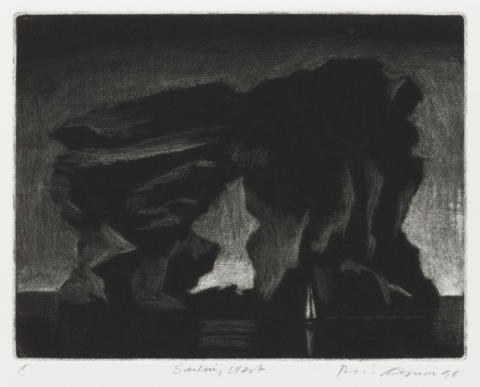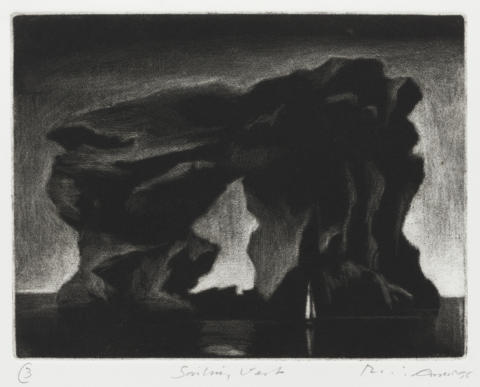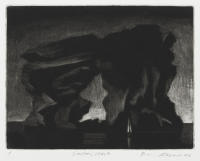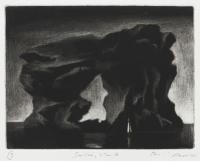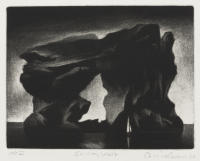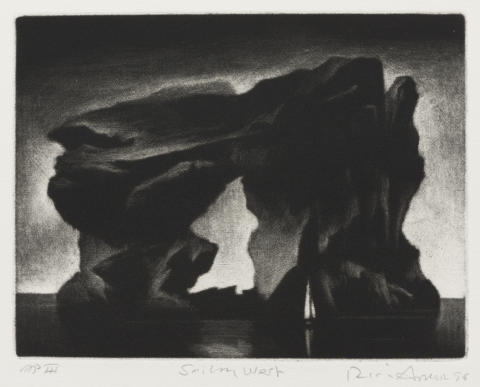
Mezzotint. A large, jagged rocky outcrop rises from the sea. At the centre of the rock formation is an irregular opening, but it is not clear whether this is a natural arch through which the distant horizon can be seen, or a hole in the rock. In front of the rock, at the right, is a small yacht, its sails resting. The composition is summarily burnished but is essentially complete.
The rocky arch has been further modelled through burnishing, with irregular outcrops added at the upper right. The sky has been burnished back and the reflection seen through the arch’s opening is lightened by an oval patch of light.
The burnishing of the plate has been evened out, and has been extended in the light areas, especially at the left. The light areas of the sky have no angular transitions and are now tonally seamless.
- Catalogue Number
- E.103
- Title and Date
- Sailing west 1996
- Description of Featured Image
- A large, jagged rocky outcrop rises from the sea, forming a natural arch through which the distant, irregular horizon can be seen. In front of the rock, at the right, is a small yacht, its sails resting.
- Where Made
- Alphington, Melbourne
- Medium Category and Technique
- Intaglio Print: Mezzotint on copper
- Support
- Wove paper. Identified papers: No papers identified.
- Dimensions
-
Image size: 155 x 206 mm
Matrix size: 157 x 207 mm - Artist’s Record Number
- RAE.110
- Printer(s) and Workshop(s)
- All impressions printed by Rick Amor in his Alphington studio.
- Summary Edition Information
- Six states. Edition of ten numbered impressions, 1996.
- Exhibitions
- Niagara Galleries 1996: Niagara Galleries, Richmond (Melbourne), Rick Amor, 4–29 June 1996, no. 38.
- Niagara Galleries at IWOP 1997: Niagara Galleries at the International Works on Paper Fair, Mitchell Galleries, State Library of New South Wales, Sydney, 17–20 July 1997, no. 1.
- Literature
- For an illustration of the painting Sailing to the west, 1996, see Niagara Galleries, Rick Amor (exh. cat.), Niagara Galleries, Richmond, Victoria, 1996, cat. no. 16.
- For a general discussion of the ‘Sailing West’ subjects, see Robert Lindsay, Rick Amor: Standing in the Shadows (exh. cat.), McClelland Gallery and Sculpture Park, Langwarrin, Victoria, 2005, p. 9.
- For illustrations of a group of later works related to E.103, see Peter Perry, Rick Amor: From Study to Painting (exh. cat.), Castlemaine Art Gallery and Historical Museum, Castlemaine, Victoria, 2013, unpaginated. These works include Study for ‘Sailing to the west’, 1996, charcoal (McClelland Sculpture Park + Gallery, Langwarrin, Victoria); Rock, Back Beach, Sorrento, 1998, watercolour (Castlemaine Art Museum); Initial sketch for ‘Journey’, 2007, sketchbook drawing (collection of the artist); and Journey, 2007, oil on canvas (Art Gallery of New South Wales).
- Collections
- State Library of Victoria, Melbourne: five state impressions, numbered 1, 2, 3, 4, 5.
- Art Gallery of Ballarat: ed. 1/10 (2008.50).
- Art Gallery of South Australia, Adelaide: ed. 4/10 (20155G146).
- Comment
The huge rocky arch depicted here is based on a natural rock formation at the ocean beach at Sorrento, Victoria. The immediate source for this mezzotint, however, is the painting Sailing to the west, 1996 (Niagara Galleries 1996), in which the rock formation as it is in reality has been dramatically transformed and has become something much grander.
Similarly in E.103, the rock, reversed in orientation, is made to appear more monumental and more bizarre than the source motif – and thus takes on a mythic quality. While the progression of states seemingly edges the image towards greater realism, the rock retains its surreal, dreamlike character to the end.
Amor has related this image to his early reading of the classics, in particular the story of Jason and the Argonauts and their quest for the Golden Fleece, a narrative that captured his imagination as a child. Robert Lindsay singles out Arnold Böcklin’s paintings of the ‘Isle of the Dead’ (Basel and elsewhere) and Goya’s Fantastic vision (Prado) as further iconographic references for Amor’s image (Lindsay 2005).
The six states of the mezzotint document incremental burnishing towards the completed image. In the first state, the burnishing marks are clearly evident, but they lose their angularity progressively, until the transitions from dark to light become imperceptible.
A charcoal drawing, Study for ‘Sailing to the west’, dated 5 February 1996 (McClelland Sculpture Park + Gallery, Langwarrin, Victoria), was made after the print (not before it, as the drawing depicts the subject in the same direction as in the mezzotint and also seems to emulate the particular tonal qualities inherent to the print). The motif of the rocky outcrop rising from the sea can also be seen in the plein-air watercolour Rock, Back Beach, Sorrento, 1998 (Castlemaine Art Museum, inv. no. 1567).
- Keywords
- Boat, Sea, Seascape, Yacht
- URL
- https://catalogue.rickamor.com.au/works/intaglio/sailing-west/
Record last updated 16/02/2021
